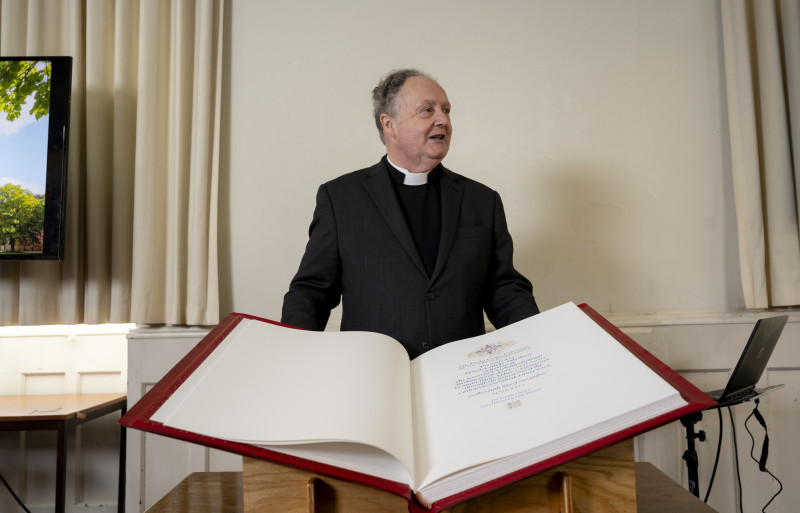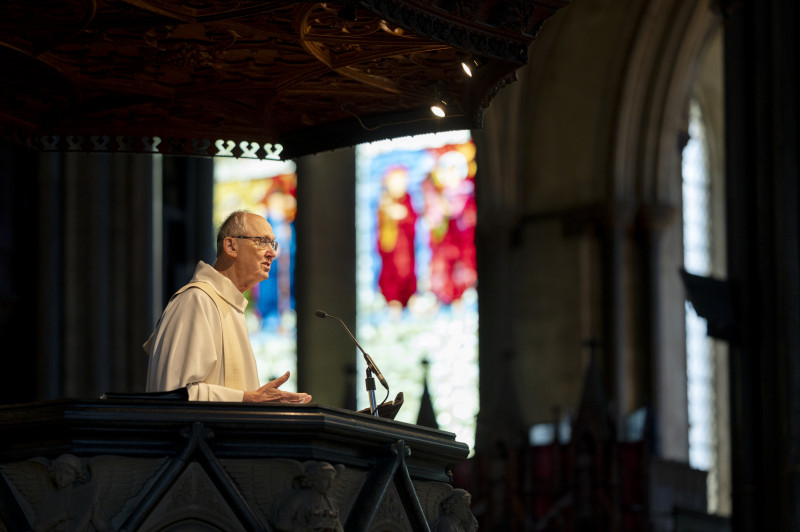29 November 2023
By James Woodward, Principal of Sarum College
It is now nearly a month since Sarum College was gifted the Saint John’s Bible.
We were glad to welcome US friends from Saint John’s Abbey and University to celebrate this gift, have it blessed by the Rt Revd Stephen Lake, Bishop of Salisbury, in his Cathedral, and to gather in Sarum  College to share a celebratory lunch. The photograph at left catches (I hope) my enthusiasm and excitement in the Cavell Room before the lecture, “Giant Bibles in the Middle Ages and Now” by academic librarian Christopher de Hamel FSA FRHistS.
College to share a celebratory lunch. The photograph at left catches (I hope) my enthusiasm and excitement in the Cavell Room before the lecture, “Giant Bibles in the Middle Ages and Now” by academic librarian Christopher de Hamel FSA FRHistS.
During the cathedral Eucharist on November 5th, The Rt Revd John Klasson, Abbot of Saint John’s Abbey (pictured below right) demonstrated the purpose of Scripture and reminded us that these ancient texts have inspired countless generations. These words have helped people to live better lives. The example of Jesus Christ given to us in the Gospels urges us to create a better world where all can live for truth and justice.
Some may think that these texts are inaccessible, remote and even irrelevant and yet Abbott John broke open the meaning of scripture in the light of our present national and international crises.
He offered words of guidance from scripture as a way of practising resilience:
“Praying the psalms, slowly, reflectively and being in silence are enormously restorative to sanity and wellbeing.
Another pathway toward resilience is service: to the poor, the hungry, those who are physically challenged, those who live alone and are home-bound. These are examples of practical charity, love made real in our awareness of the needs of others.”
We were reminded too that these ancient texts are relevant to our daily lives. They can help us to nurture well-being, resilience and flourishing.
In an age of e-books and screens, it may seem rather antiquated to create a handwritten, illuminated Bible. These seven volumes have been produced using traditional methods and materials while engaging contemporary questions and concerns. What we have here is a physical form of the text which has all the capacity to exert a kind of formation in the hermeneutical and theological imaginations of those who read it.
It slows us up to attend carefully, to look at the detail and wonder about the beauty of God’s revelation in his word.
Word and image belong together in a dialogue. When working on the text of Luke’s gospel (pictured below, left), head calligrapher Donald Jackson sought to illuminate the story of the Prodigal Son on the 11th of September 2001, the day the Twin Towers in New York City were destroyed with devastating consequences for the world. Jackson uses the image to ask us then and now what reconciliation and renewal might look like.

I think the Saint John’s Bible very creatively restores the language of beauty within the Christian tradition by offering a reimagining and a reminder of power and persuasion as the gospels’ proclamation of peace that passes all understanding. This is a promise of a transformation which can make all things new.
In a church anxious about its future and engaged in profound disagreements perhaps the Saint John’s Bible might point us to the power and possibility of beauty as mission. Artistic witness is a peaceful mode of persuasion that invites participation in divine beauty. A greater understanding and appreciation of the transformative power of beauty can aid us in tuning human souls to divine harmony, to participating in the Kingdom of God.
This gift already is beginning to yield its promises and possibilities. I promised to cherish it at Sarum College and use it for our work of learning for human flourishing. What an exciting companion for this journey.
Read the Church Times (£) interview with calligrapher Donald Jackson.
All welcome to the Open Week ending 1 December 2023
Read the Homily by The Rt Revd John Klassen
Main and two top images by Peter Langdown Photography

Leave a Reply